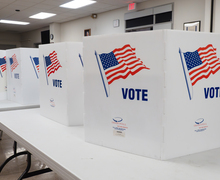Sullivan: Voters should not be hesitant to vote Green Party
Jill Stein, physician and longtime politician, was on the Green Party’s ticket in the 2012 presidential election. This year, she is vying for the same spot.
And while she doesn’t have the name-recognition of a Bush or a Clinton, she’s the type of candidate voters are waiting for. But first, she must overcome the difficulties of being a third-party candidate.
Stein appeared on PBS’ “Tavis Smiley” last week, where she discussed her fight to be heard by voters. For a candidate who identifies as neither Democrat nor Republican, she is nixed from national debates and receives little to no media coverage.
For candidates like Stein, a lack of media coverage adds to the bigger issue: third-party politics has a bad rap. However, minor-party agendas are exactly what voters are asking for this election season — they just don’t know it yet. Despite preconceived notions that third-party politics do not belong in the big leagues, voting Green can be a solution for liberals who think Democratic candidates can do more.
In fact, taking a look at Stein’s campaign platform feels a little too familiar. Many of Stein’s stances on issues, like raising the minimum wage and climate change, seem very similar to a 74-year-old Vermont senator named Bernie Sanders (D). A closer look reveals that Stein seems to address, albeit bluntly, policies that have until recently been a particular weak spot of the Sanders campaign.
One of these has been addressing the issues championed by the activist organization Black Lives Matter. Stein vows to end “police brutality, mass incarceration and institutional racism within our justice system.” Some of these issues have been now addressed by Sanders and even Kentucky Sen. Rand Paul (R), yet BLM has dropped political ties and has yet to endorse any candidate.
Stein also remembers another minority group that most everyone else seems to forget: Native Americans. Stein’s plan includes a promise to defend indigenous rights and land, a statement that sets the physician aside from any other presidential hopeful by taking a closer look into America’s civil rights struggles.
Green Party candidates like Stein are farther left on the spectrum and removed from mainstream politics, many qualities that tie into today’s anti-establishment trend in the presidential race.
But voting Green is only as powerful as the voters themselves. Voters feel as if they will have wasted their ballot instead of supporting a candidate with a larger chance of winning. Minimal media coverage only fans the flames — if the media isn’t covering it, we tend to think that we shouldn’t talk about it.
Following Donald Trump’s 2016 ride shows how powerful a voter truly can be. Pundits predicted he would barely register on the polls, but the individual voters that chose to express their political dissatisfaction with the current system and support Trump changed the course of the election.
The same can be done for the Green Party, starting at the individual level. If people who wanted to vote Green actually committed to the party, people like Jill Stein could become a household name.
Voters are not compromising in mainstream politics, yet they are still too afraid to venture outside of the two parties. What they are looking for may lie beyond blue and red if they have the conviction to take it.
Keely Sullivan is a senior broadcast and digital journalism and French dual major. Her column appears weekly. She can be reached at kasull02@syr.edu and followed on Twitter @specialksully.
Published on September 30, 2015 at 11:52 pm






